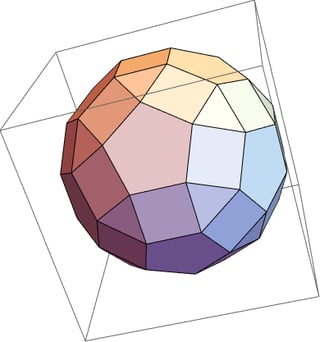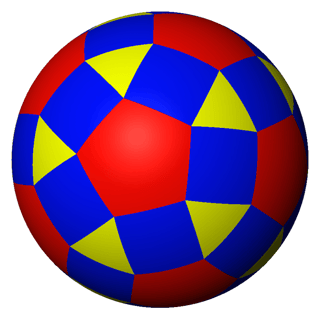As a first pass, we can approximate the odds of landing on a face by projecting the polyhedron on a sphere, and taking the fraction of the sphere which it covers.


Then the odds of a triangular, square or pentagonal roll overall are
$$14.4\%,\ 50.4\%,\ 35.1\%$$
and the odds for an individual triangular, square or pentagonal face are
$$0.72\%,\ 1.68\%,\ 2.93\%.$$
This is Simpson's method. It also represents the result of throwing the die high above an adhesive surface, so that the die is well-randomized in the air, and then after touching the surface falls onto the nearest side.
The angles have exact formulas which are easy enough to calculate in Mathematica:
data = PolyhedronData["SmallRhombicosidodecahedron"];
faces = Map[data[[1, 1]][[#]] &, data[[1, 2, 1]]];
angle[a_, b_, c_] := 2 ArcTan[Abs[a.Cross[b, c]]/
(Norm[a] Norm[b] Norm[c] + a.b Norm[c] + b.c Norm[a] + c.a Norm[b])];
Map[Length[#] angle[# // Mean // Simplify, #[[1]], #[[2]]] &, faces]
// FullSimplify // Union
This gives the following solid angle measures for each triangular, square or pentagonal face:
$$6 \cot^{-1}\left(2 \sqrt{3} u+\sqrt{124 u-61}\right),\\
8 \cot^{-1}\left(2u+\sqrt{40 u-21}\right),\\
10 \cot^{-1}\left(2 \sqrt{5u}+3 \sqrt{2u+1}\right)$$
where $u=5+2\sqrt{5}$.


